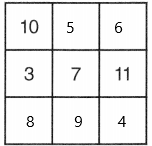By accessing our 180 Days of Math for Fifth Grade Answers Key Day 170 regularly, students can get better problem-solving skills.
180 Days of Math for Fifth Grade Answers Key Day 170
Directions: Solve each problem.
Question 1.
161 – 56 = ___________
Answer:
Subtraction is one of the four basic arithmetic operations in mathematics. We can observe the applications of subtraction in our everyday life in different situations. For example, when we purchase fruits and vegetables for a certain amount of money say Rs. 200 and we have given an Rs. 500 note to the vendor. Now, the vendor returns the excess amount by performing subtraction such as 500 – 200 = 300. Then, the vendor will return Rs. 300.
Now we need to calculate the above-given question:
We need to subtract 161 and 56

161 = Minuend; 56 = Subtrahend; 105 = Difference
Therefore, the answer is 105.
Question 2.
0.89 × 0.26 = ___________
Answer:
In mathematics, multiplication is a method of finding the product of two or more numbers. It is one of the basic arithmetic operations, that we use in everyday life. The major application we can see in multiplication tables.
In arithmetic, the multiplication of two numbers represents the repeated addition of one number with respect to another. These numbers can be whole numbers, natural numbers, integers, fractions, etc. If m is multiplied by n, then it means either m is added to itself ‘n’ number of times or vice versa.
The formula for multiplication:
The multiplication formula is given by:
Multiplier × Multiplicand = Product
– The multiplicand is the total number of objects in each group
– A multiplier is the number of equal groups
– Product is the result of multiplication of multiplier and multiplicand
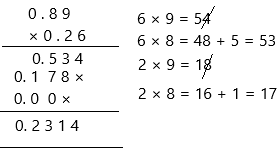
Therefore, the answer is 0.2314
Question 3.
![]()
Answer:
The square root of a number is defined as the value, which gives the number when it is multiplied by itself. The radical symbol √ is used to indicate the square root. For example, √9 = 3. The radical symbol is also called a root symbol or surds. If a number is a perfect square, we can easily find the square root of the number. If the given number is not a perfect square number, the square root can be found using the long division method.
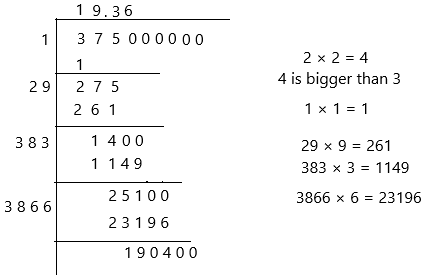
The square root of 375 with one digit decimal accuracy is 19.36. Did you notice that the last two steps repeat the previous two steps? You can add decimals by simply adding more sets of 00 and repeating the last two steps over and over.
therefore, the square root of 375 is 19.36
The above-given question is 28 square root of 375 is:
We got a square root of 375 is 19.36
Now multiply 28 by 19.36
Thus, 28*19.36 is 542.08
Question 4.
Round 79,503 to the nearest thousand.
Answer: 80,000
Explanation:
Rounding is the process of adjusting digits to make calculations easy and quick.
We need to round the nearest 1000 then we have to see first in the hundreds place.
to round multi-digit whole numbers to the nearest 10,000, 100,000, and 1,000,000. All we need to do is follow the usual steps: choose the target digit, check if the digit to its right is < or ≥ 5, and round the number accordingly.
By following the above rule we can easily round up the values.
The number in the hundreds place is 5. So, rounding up we have 80,000
Question 5.
Simplify \(\frac{15}{20}\).
Answer:
\(\frac{15}{20}\) can be written as 15/20
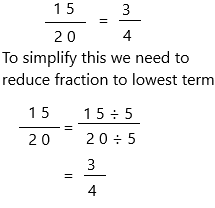
5 is the greatest common divisor of 15 and 20. Reduce by dividing both numerator and denominator by 5.
Question 6.
19 • 9 – 8 • 5 = ___________
Answer:
In mathematics, multiplication is a method of finding the product of two or more numbers. It is one of the basic arithmetic operations, that we use in everyday life. The major application we can see in multiplication tables.
In arithmetic, the multiplication of two numbers represents the repeated addition of one number with respect to another. These numbers can be whole numbers, natural numbers, integers, fractions, etc. If m is multiplied by n, then it means either m is added to itself ‘n’ number of times or vice versa.
The formula for multiplication:
The multiplication formula is given by:
Multiplier × Multiplicand = Product
– The multiplicand is the total number of objects in each group
– A multiplier is the number of equal groups
– Product is the result of multiplication of multiplier and multiplicand
19 • 9 = 171
8 • 5 = 40
Now subtract the numbers we got. Let the answer be X.
X=171-40
X=131.
therefore, the value of the given expression is 131.
Question 7.
4 × 4 =  ÷ 1
÷ 1
Answer:
Let the empty box be X
4 × 4 = X ÷ 1
16 = X ÷ 1
If the answers are equal on both sides then the answer will be correct.
If we put X value as 16 then the expression will be:
16=16 ÷ 1
16=16
Therefore, the answer is verified.
Question 8.
3 pints = __________ cups
Answer:
The conversion factor from pints to cups is 2, which means that 1 pint is equal to 2 cups:
1 pint = 2 cups
To convert 3 pints into cups we have to multiply 3 by the conversion factor in order to get the volume amount from pints to cups. We can also form a simple proportion to calculate the result:
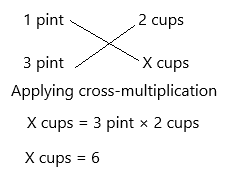
therefore, the final result is 3 pints is equal to 6 cups.
Question 9.
Is the height of a house’s front door most likely 75 inches or 75 centimetres?
Answer: 75 inches.
We usually measure the house front door in inches. Moreover, there will be a standard size also.
The standard size for an exterior door is 80 inches by 36 inches which is 6 ft.
Question 10.
Books Read

The boys’ parents will take them to the movies as a reward after they have read 100 books. How many more books does Mark have to read to get the reward?
Answer:
The number of books Mark read=10*6=60 books.
The number of books Mark wants to read=100
The number of more books Mark have to read=X
X=100-60
X=40.
Therefore, 40 books more to read.
Question 11.
You make trail mix using the following ingredients: 25 candies, 50 raisins, 75 pieces of cereal, and 50 peanuts. If you reach in the bowl and grab one piece of food, what is the probability you will not grab a peanut?
Answer:
This formula is the number of favourable outcomes to the total number of all the possible outcomes that we have already decided in the Sample Space.
The probability of an Event = (Number of favourable outcomes) / (Total number of possible outcomes)
P(A) = n(E) / n(S)
P(A) < 1
Here, P(A) means finding the probability of an event A, n(E) means the number of favourable outcomes of an event and n(S) means the set of all possible outcomes of an event.
Total number of possible outcomes=25+50+75+50=200
Number of favourable outcomes of an event means there is a probability of getting 25 candies, 50 raisins, 75 pieces of cereal. So there are 150 possibilities.
P(A)=150/200
P(A)=3/4
Number of favourable outcomes of an event not occuring=1-P(A)
1-3/4
=4-3/4
=1/4.
Therefore, the probability you will not grab a peanut is 1/4.
Question 12.
Complete the magic square using each number 3-11 only once.
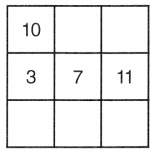
Answer:
In a 3×3 magic square, there are 8 places where there are 3 squares in a straight line: 3 rows, 3 columns, and 2 diagonals.
Each square in a corner is in 3 of those – one row, one column, and one diagonal.
Each square on a side is in only 2 of those – one row and one column.
And the square in the middle is in 4 of those – one row, one column, and both diagonals.
When you are filling in a 3×3 magic square using consecutive integers, the middle number always goes in the middle square; and the sum of each row, column, and diagonal is 3 times that number. So when using the numbers 3 to 11, the number 7 is in the middle, and the magic sum is 21.
– Make a list of all the ways of adding three of the numbers 3 to 11 to get a sum of 21
3+7+11; 6+7+8; 5+6+10; 5+7+9; 4+8+9; 4+6+11; Likewise check all the possibilities.
– The numbers 3, 5, 9, and 11 each appear twice in that list of sums, so they must be the numbers on the sides of the square. Place them any way you want so that the 3 and 11 are in a straight line and the 7 and 9 are in a straight line:
– The numbers yet to be placed are 5, 6, 8, and 4. We have to find their places. 10 already given.
– In the first column, the bottom number has to add to 8, so it has to be 8. And in the first row, the second and last numbers have to add to 11, so they must be 5 and 6.
– And then it is easy to see where to place the to make all the rows, columns, and diagonals have the magic sum of 21:
